Republic-Ford JB-2
| JB-2/KGW Loon | |
|---|---|
|
Republic/Ford JB-2 at the National Museum of the United States Air Force. | |
| Type | Cruise missile |
| Place of origin | United States |
| Service history | |
| In service | 1945–50 |
| Used by |
United States Army Air Forces United States Air Force United States Navy |
| Production history | |
| Manufacturer |
Republic Aircraft Willys-Overland Ford Motor Company |
| Produced | 1944–45 |
| Number built | 1,391 |
| Specifications | |
| Weight | 5,000 pounds (2,300 kg) |
| Length | 27 feet 1 inch (8.26 m) |
| Diameter | 34 inches (860 mm) |
| Warhead | High explosive |
| Warhead weight | 2,000 pounds (910 kg) |
|
| |
| Engine |
Ford PJ31 pulsejet 660 lbf (2.9 kN) |
| Wingspan | 17 feet 8 inches (5.38 m) |
Operational range | 150 miles (240 km) |
| Speed | 425 miles per hour (684 km/h) |
Guidance system | Radio command |
| Accuracy | 0.25 miles (0.40 km) at 100 miles (160 km) |
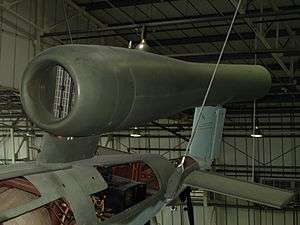
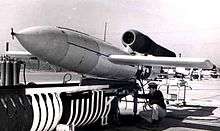
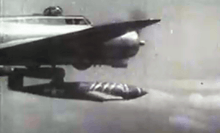

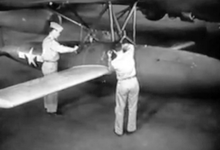
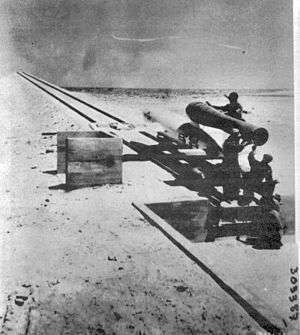

The Republic-Ford JB-2, also known as the KGW and LTV-N-2 Loon, was a United States copy of the German V-1 flying bomb. Developed in 1944, and planned to be used in the United States invasion of Japan (Operation Downfall), the JB-2 was never used in combat. It was the most successful of the United States Army Air Forces Jet Bomb (JB) projects (JB-1 through JB-10) during World War II. Postwar, the JB-2 played a significant role in the development of more advanced surface-to-surface tactical missile systems such as the MGM-1 Matador and later MGM-13 Mace.
Wartime development
The United States had known of the existence of a new German secret weapon since 22 August 1942 when a Danish Naval Officer discovered an early test version of the V-1 that had crashed on the island of Bornholm, in the Baltic Sea between Germany and Sweden. A photograph and a detailed sketch of the V-1 test unit, the Fieseler Fi 103 V83 (Versuchs-83, the eighty-third prototype airframe) was sent to Britain. This led to months of intelligence-gathering and intelligence-sifting which traced the weapon to Peenemünde, on Germany's Baltic Coast, the top-secret German missile test and development site.[1]
As more intelligence data was obtained through aerial photography and sources inside Germany, it was decided in 1943 for the United States to develop a jet-powered bomb as well. The United States Army Air Forces gave Northrop Aircraft a contract in July 1944 to develop the JB-1 (Jet Bomb 1) turbojet-powered flying bomb under project MX-543. Northrop designed a flying-wing aircraft with two General Electric B1 turbojets in the center section, and two 900 kg (2000 lb) general purpose bombs in enclosed "bomb containers" in the wing roots. To test the aerodynamics of the design, one JB-1 was completed as a manned unpowered glider, which was first flown in August 1944.[1]
In July 1944, three weeks after German V-1 "Buzz Bombs" first struck England on 12 and 13 June, American engineers at Wright Field, fired a working copy of the German Argus As 014 pulse-jet engine, "reverse-engineered" from crashed German V-1s that were brought to the United States from England for analysis. The reverse engineering provided the design of America's first mass-produced guided missile, the JB-2.[2]
By 8 September, the first of thirteen complete JB-2s, reverse engineered from the material received at Wright Field in July was assembled at Republic Aviation. The United States JB-2 was different from the German V-1 in only the smallest of dimensions. The wing chord was only 2½ inches wider and the wingspan was extended less than 2 feet (0.61 m). The difference gave the JB-2 60.7 square feet of wing area versus 55 for the V-1.[1] One of the few visible differences between the JB-2 and the V-1 was the shape of the forward pulsejet support pylon — the original V-1 had its support pylon slightly swept back at nearly the same angle on both its leading and trailing edges, while the JB-2's pylon had a vertical leading edge and sharply swept-forward trailing edge.
With its Ford-produced PJ31 pulsejet powerplant, the JB-2 was one of the first attempts at a powered cruise missile for potential usage in America's arsenal. The JB-2 had nothing more advanced than what the Germans had already placed aboard their V-1 for guidance, while the indigenously-designed, unpowered U.S. Navy's Bat anti-ship missile already had an active radar homing system in its nose to locate its intended maritime targets. The first launch of a JB-2 took place at Eglin Army Air Field in Florida by the 1st Proving Ground Group on 12 October 1944. In addition to the Eglin group, a detachment of the Special Weapons Branch, Wright Field, Ohio, arrived at Wendover Field, Utah, in 1944 with the mission of evaluating captured and experimental systems, including the JB-2. Testing was from a launch structure just south of Wendover's technical site. The launch area is visible in aerial imagery (40°41′53″N 114°02′29″W / 40.69806°N 114.04139°W). Parts of crashed JB-2s are occasionally found by Wendover Airport personnel.[1]
In December 1944, the first JB-1 was ready for launch. The missile was launched by a rocket-propelled sled along a 150 m (500 ft) long track, but seconds after release the JB-1 pitched up into a stall and crashed. This was caused by an incorrectly calculated elevon setting for take-off, but the JB-1 program was subsequently stopped, mainly because the performance and reliability of the GE B1 turbojet engines were far below expectations. In addition, the cost to produce the Ford copy of the Argus pulse-jet engine of the JB-2 was much less than the GE turbojets. Subsequently work proceeded on the JB-2 for final development and production.[1][3]
An initial production order was 1,000 units, with subsequent production of 1,000 per month. That figure was not anticipated to be attainable until April 1945. Republic had its production lines at capacity for producing P-47 Thunderbolts, so it sub-contracted airframe manufacturing to Willys-Overland. Ford Motor Co built the engine, initially designated IJ-15-1, which was a copy of the V-1's 900-lb. thrust Argus-Schmidt pulse-jet (the Argus As 014), later designated the PJ31. Guidance and flight controls were manufactured by Jack and Heintz Company of Cleveland, Ohio, and Monsanto took on the task of designing a better launching system, with Northrop supplying the launch sleds. Production delivery began in January 1945.[1]
An envisioned 75,000 JB-2s were planned for production. A USAAF launching squadron was formed in anticipation for using the weapons both against Nazi Germany and Japan. However, the end of the European War in May 1945 meant a reduction of the number of JB-2s to be produced, but not the end of the program. Army commanders in Europe had dismissed it as a weapon against Nazi Germany, as the strategic bombing concept was implemented and by 1945 the number of strategic targets in Germany was becoming limited. However, the JB-2 was envisioned as a weapon to attack Japan. A 180-day massive bombardment of the Japanese Home Islands was being planned prior to the amphibious landing "by the most powerful and sustained pre-invasion bombardment of the war". Included in the assault were the usual naval bombardment and air strikes augmented by rocket-firing aircraft and JB-2s.[1]
A navalized version, designated KGW-1, was planned to be used against Japan from LSTs (Landing Ship, Tank) as well as escort carriers (CVEs). In addition, launches from PB4Y-2 Privateers were foreseen and techniques developed. The official U.S. Air Force Fact Sheet on the JB-2 states just before the end of the war, an aircraft carrier en route to the Pacific took on a load of JB-2s for possible use in the planned invasion of the Japanese home islands; the name of the carrier has never been identified. In addition, according to one Eglin AFB history, an unidentified USAAF unit in the Philippines was preparing to launch JB-2s against Japan.[1] The war's end led to the cancellation of Operation Downfall and the production of JB-2s was terminated on 15 September. A total of 1,391 units were manufactured.[1]
Postwar testing
The U.S. Army Air Forces continued development of the JB-2 as Project MX-544, with two versions — one with preset internal guidance and another with radar control. Several launch platforms were developed, including permanent and portable ramps, and mobile launching from beneath the wings of Boeing B-17G or Boeing B-29 bombers, much as the Heinkel He 111H-22 had done late in the war for the Luftwaffe in offensive air-launches of V-1s against the Allies. Testing continued from 1944 to 1947 at Eglin to improve launch and guidance.
The U.S. Navy's version, the KGW-1, later redesignated LTV-N-2, was developed to be carried on the aft deck of submarines in watertight containers. The first submarine to employ them was USS Cusk (SS-348) which successfully launched its first Loon on 12 February 1947, off Point Mugu, California. USS Carbonero (SS-337) was also modified to test Loon.
After the United States Air Force became a fully independent arm of the National Military Establishment 18 September 1947, research continued with the development of unmanned aircraft and pilotless bombers, including the already available JB-2.
The USAF Air Materiel Command reactivated the JB-2 as Project EO-727-12 on 23 April 1948, at Holloman AFB, New Mexico, the former Alamogordo Army Air Field. The JB-2 was used for development of missile guidance control and seeker systems, testing of telemetering and optical tracking facilities, and as a target for new surface-to-air and air-to-air missiles (fulfilling the V1's covername, Flakzielgerät — anti-aircraft target device). The JB-2 project used the North American Aviation NATIV (North American Test Instrument Vehicle) Blockhouse and two launch ramps at Holloman: a 400 ft (120 m), two-rail ramp on a 3° earth-filled slope, and a 40 ft (12 m) trailer ramp. The trailer ramp was the first step toward a system which would eventually be adapted for the forthcoming Martin MGM-1 Matador, the first operational surface-to-surface cruise missile built by the United States. The program at Holloman was terminated on 10 January 1949 after successful development of a radio guidance and control system that could control and even skid-land a JB-2 under the control of an airborne or ground transmitter.[1]
The 1st Experimental Guided Missiles Group used JB-2s in a series of tests in the late 1940s at Eglin Air Force Base, Florida. In early 1949, the 3200th Proof Test Group tested launching JB-2s from the under the wings of B-36 Peacemaker bombers at Eglin AFB.[4] About a year later, JB-2s were tested as aerial targets for experimental infrared gunsights at Eglin.[5]
The Navy version was featured in the movie The Flying Missile (1951), including submarine launches. The movie shows the missile being launched from a trolley with four JATO bottles.
In the mid-1992, military crews uncovered the well-preserved wreckage of a JB-2 at a site on an Air Force-owned section of Santa Rosa Island. Most crash sites on the barrier island were little more than flaky rust, but after the find, officials were planning further searches.[6]
JB-2 survivors
- National Museum of the United States Air Force, Dayton, Ohio
- U.S. Air Force Armament Museum, Eglin AFB, Florida
- Evergreen Aviation & Space Museum, McMinnville, Oregon
- (Engine only, operational) Planes of Fame air museum, Chino, California
- A JB-2 is on open-air display at the Museum of Alaska Transportation and Industry in Wasilla, Alaska.
- Museum of Transport and Technology (MOTAT), Auckland, New Zealand
- Hill Aerospace Museum, Hill AFB, Utah has an original JB-2, "Wendover Willie"
- Point Mugu Missile Park, on open-air display at Naval Air Station Point Mugu, California.
- Cradle of Aviation Museum, Garden City, New York.
- National Air and Space Museum at the Steven F. Udvar-Hazy Center, Chantilly, Virginia
- Milford Township Park at Milford, IL.[7]
- A JB-2 is on open-air display at the American Legion post in Wheaton, Minnesota.
- A JB-2 is on open-air display at White Sands Missile Range Museum
- A JB-2 is on open-air display at the U.S. Army Artillery Museum, Fort Sill, Oklahoma.
See also
- Related development
- Aircraft of comparable role, configuration and era
Launch locations
- Wendover Air Force Base, Utah JB-2 Testing Site (40°41′52″N 114°02′29″W / 40.69778°N 114.04139°W)
- Holloman Air Force Base, New Mexico JB-2 Testing Site (32°53′33″N 106°07′24″W / 32.89250°N 106.12333°W)
- Santa Rosa Island Range Complex, JB-2 Launch Sites 30°23′57″N 086°42′21″W / 30.39917°N 86.70583°W (30°23′54″N 086°41′33″W / 30.39833°N 86.69250°W)
- Wagner Field, Florida (Formerly: Eglin Air Force Auxiliary Field #1) (30°39′46″N 086°20′41″W / 30.66278°N 86.34472°W)
References
![]() This article incorporates public domain material from the Air Force Historical Research Agency website http://www.afhra.af.mil/.
This article incorporates public domain material from the Air Force Historical Research Agency website http://www.afhra.af.mil/.
- 1 2 3 4 5 6 7 8 9 10 U.S. Air Force Tactical Missiles, (2009), George Mindling, Robert Bolton ISBN 978-0-557-00029-6
- ↑ USAFHRA document 01014091
- ↑ Garry R. Pape, John M. Campbell: "Northrop Flying Wings", Schiffer Publishing Ltd., 1995
- ↑ USAFHRA Document 00103281
- ↑ USAFHRA Document 00425257
- ↑ Associated Press, "V-1 copy sparks interest," Northwest Florida Daily News, Fort Walton Beach, Florida, 1 October 1992, p. 1B
- ↑ http://www.warbirdsandairshows.com/illinoisgateguards.htm
- USAF JB-2 LOON (fact sheet), National Museum.
- Mindling, George, and Bolton, Robert, 'U.S. Air Force Tactical Missiles 1949–1969: The Pioneers', 2008, Lulu Press
External links
| Wikimedia Commons has media related to Republic-Ford JB-2. |
- Early History and Evolution of cruise missiles, JB-2 Loon development and testing, USAF 38th Tactical Missile Wing.
- JB Series (JB-1 through JB-10) Directory of U.S. Military Rockets and Missiles
- V-1 "Buzz Bomb"/JB-2 Flying Bomb Fact Sheet at Hill Air Force Base website
- Short JB-2 launch from a B-17 video clip
- JB-2 launches video
- Ford PJ31 pulsejet test run at the Planes of Fame museum
_USAF.jpg)
